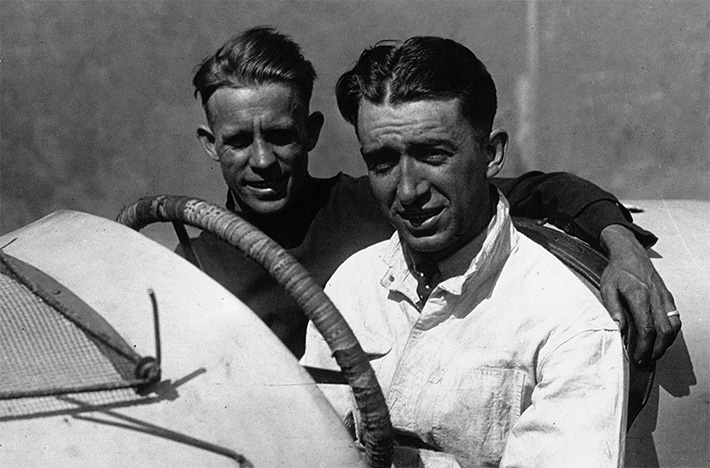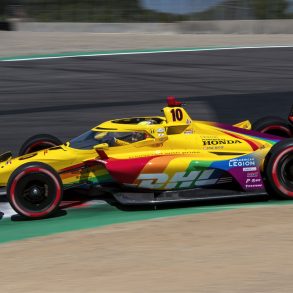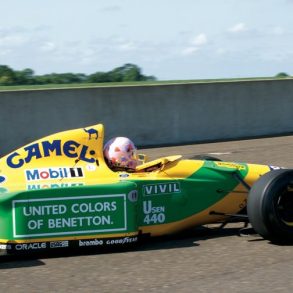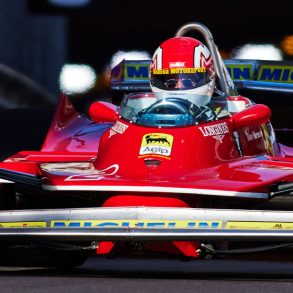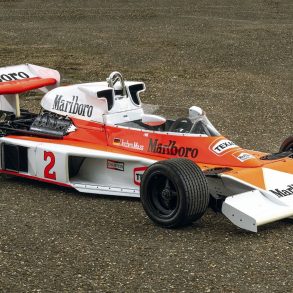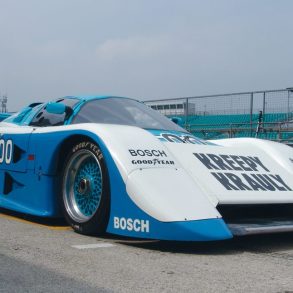Jimmy Murphy Biography
Jimmy Murphy was born in 1894 but tragedy soon struck the Murphy family when his mother died while Murphy was two and his father succumbed to injuries suffered in the great San Francisco Earthquake of 1906 which left Murphy an orphan. Forced to work for a living at a young age he eventually found employment in a garage in downtown Los Angeles frequented by the local California board track racing fraternity.
Velodromes originated in France and were mostly constructed of wood. These board tracks first appeared around the turn of the century, originally for bicycles and later involving motorcycles. The Playa Del Rey board track opened in 1910 at the Los Angeles Coliseum Motordome was the first of the great wood plank automobile speedways. For years bicycle and motorcycle races were conducted on wooden velodromes, but Playa Del Rey, designed by Jack Prince brought the concept to events for race cars. Unfortunately the track burned down as wood will in 1913.

One week before the race during practice, Murphy was involved in a major crash landing in a ditch with the car on top of him. He had just taken Louis Inghibert, a Frenchman who was scheduled to drive one of the four Duesenberg entries, for a few laps of the 10.7-mille course. The brakes locked and the car did a few somersaults. Both men were taken to hospital, Inghibert with four broken ribs and Murphy suffering from various internal injuries. Any other driver would have taken the next ship home but Murphy was a board man and like others of his craft often had to drive injured. Confined to a hospital bed until two hours before the race and bandaged from waist to shoulders he turned up at the circuit to the consternation of the French officials. After being assisted into his car at the start he went on and won the great classic race at an average speed of 78.1 m.p.h., shattering all several road racing records in the process. When he crossed the finishing line he had two flat tyres and a flying stone had torn a gaping hole in his radiator, but Murphy had given the other drivers a lesson in courage they would not soon forget.

Later that year a three-way feud erupted among Fred Duesenberg, Murphy, and Murphy’s patron, Tommy Milton. The beginnings of the feud is unclear and there is some controversy over whether it ever really existed beyond the natual rivalry between very competetive men. Murphy had set a new speed record in a special built car that he was only hired to prepare for Milton and later after the French victory, Murphy endeavored to purchase the car that won in France from Fred Duesenberg. During this time in American racing there was a fierce competition growing between Harry Miller on the West Coast and Duesenberg on the East. Miller had just produced his own 183-cu.-in engine and it was starting to make some noise. Murphy purchased one of the Miller engines and promptly placed it in his Duesenberg to the consternation of Fred. Calling his new hybrid the Murphy Special he competed and won the 1922 Indianapolis 500. Murphy would also win the National Championship for that year.
1923 placed second in the National Championship, even though he missed several races to go to Europe. He placed third in the Italian Grand Prix that year as part of a three Miller team. The leading competition was provided by FIAT 805s which were equipped with superchargers. Last year winner, Pietro Bordino broke his arm in practice and started the race with his arm in a cast attached to the steering wheel with a rubber band! Though spend the first part of the race at the front he could not continue due to the pain. The Miller’s brakes built for the ovals of the United States could not take the strain of road racing. The cable to the rear brakes snapped yet incredibly Murphy continued to race and with only his front brakes operating he finished a brave third.
On September 15, 1924 Jimmy Murphy met his death on a dirt track. It was the 150 mile AAA championship event at the State Fair Grounds at Syracuse, New York. With 138 of the 150 miles already run Murphy attempted to overtake Phil Shafer. His Miller Special clipped the inside rail, then skidded and hit the fence a second time, crashing through. Although the car did not overturn, wooden splinters from the rail struck Murphy in the chest and abdomen apparently causing his death. When the AAA championship points were tabulated at the end of the year, Murphy was awarded the AAA Championship posthumously.








